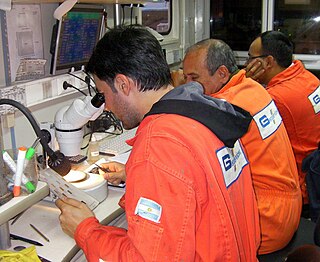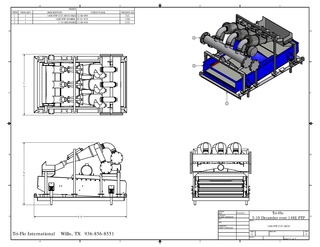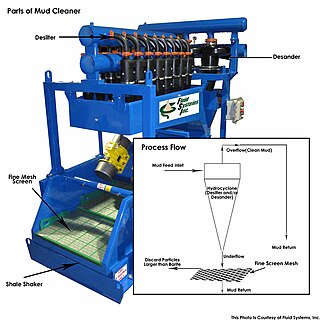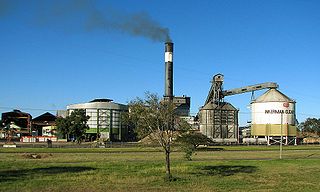
Solids control is a process used in drilling rigs which use drilling fluid. It involves separating the "cuttings" (drilled material) from the fluid, allowing it to be recirculated or discharged to the environment. [1]

Solids control is a process used in drilling rigs which use drilling fluid. It involves separating the "cuttings" (drilled material) from the fluid, allowing it to be recirculated or discharged to the environment. [1]
Drilling rigs are drilling systems for creating boreholes in the ground. They use drilling fluid (also known as drilling mud) as lubricant and coolant for the drill bit and to clear the cuttings out of the hole. The drilling fluid needs to have the cuttings removed before being recirculated or discharged, which is achieved by the solids control system attached to the rig. [2] [1]
Solids control systems consist of several stages of treatment, removing progressively finer particles from the drilling fluid.
The principle of screen separation is to pass the drilling fluid over the screens with different size holes, allowing fluid and small particles to pass through while separating larger particles. It is used to filter large solids out of the drilling mud, typically with particle sizes above 75μm. [1] The machines that use this principle are called shale shakers, and consist of a series of vibrating screens that the mud passes over. When working effectively these machines can remove up to 80% of the cuttings from the drilling fluid. [3]
Settling separation relies on gravity to draw solid particles down through the fluid in vessels called mud pits or silt pits. The fluid flow rate is reduced, allowing the particles to drift down while the clean fluid is drawn off. [3] This stage of separation deals with particle sizes between 15μm and 74μm. [1]
Forced separation relies on percieved centrifugal force pushing solid particles to the outside of a rotating body of fluid. Machines that use this principle include centrifuges and hydrocyclones. The drilling fluid is injected into a cone-shaped vessel at high pressure, allowing the clean fluid to be drawn off from the top of the chamber. [3] An alternate design relies on a rapidly rotating drum, which flings the solids in the drilling fluid to the outside of the cylinder to be drawn off as a thick sludge. [4]
Sometimes gas can get into the drilling fluid from the rock that the borehole passes through. This can reduce the density of the fluid, causing structural issues in the well. [5] A vacuum is applied to remove the gas from the fluid, then vented or flared off. [3]

Filtration is a physical, biological or chemical operation that separates solid matter and fluid from a mixture with a filter medium that has a complex structure through which only the fluid can pass. Solid particles that cannot pass through the filter medium are described as oversize and the fluid that passes through is called the filtrate. Oversize particles may form a filter cake on top of the filter and may also block the filter lattice, preventing the fluid phase from crossing the filter, known as blinding. The size of the largest particles that can successfully pass through a filter is called the effective pore size of that filter. The separation of solid and fluid is imperfect; solids will be contaminated with some fluid and filtrate will contain fine particles. Filtration occurs both in nature and in engineered systems; there are biological, geological, and industrial forms.

A centrifuge is a device that uses centrifugal force to separate various components of a fluid. This is achieved by spinning the fluid at high speed within a container, thereby separating fluids of different densities or liquids from solids. It works by causing denser substances and particles to move outward in the radial direction. At the same time, objects that are less dense are displaced and move to the centre. In a laboratory centrifuge that uses sample tubes, the radial acceleration causes denser particles to settle to the bottom of the tube, while low-density substances rise to the top. A centrifuge can be a very effective filter that separates contaminants from the main body of fluid.

An oil well is a boring in the Earth that is designed to bring petroleum oil hydrocarbons to the surface. Usually some natural gas is released as associated petroleum gas along with the oil. A well that is designed to produce only gas may be termed a gas well.
In petroleum exploration and development, formation evaluation is used to determine the ability of a borehole to produce petroleum. Essentially, it is the process of "recognizing a commercial well when you drill one".

A hydrocyclone is a device to classify, separate or sort particles in a liquid suspension based on the ratio of their centripetal force to fluid resistance. This ratio is high for dense and coarse particles, and low for light and fine particles. Hydrocyclones also find application in the separation of liquids of different densities.

A drilling rig is an integrated system that drills wells, such as oil or water wells, in the earth's subsurface. Drilling rigs can be massive structures housing equipment used to drill water wells, oil wells, or natural gas extraction wells, or they can be small enough to be moved manually by one person and such are called augers. Drilling rigs can sample subsurface mineral deposits, test rock, soil and groundwater physical properties, and also can be used to install sub-surface fabrications, such as underground utilities, instrumentation, tunnels or wells. Drilling rigs can be mobile equipment mounted on trucks, tracks or trailers, or more permanent land or marine-based structures. The term "rig" therefore generally refers to the complex equipment that is used to penetrate the surface of the Earth's crust.
A mud engineer works on an oil well or gas well drilling rig, and is responsible ensuring the properties of the drilling fluid, also known as drilling mud, are within designed specifications.

In geotechnical engineering, drilling fluid, also called drilling mud, is used to aid the drilling of boreholes into the earth. Often used while drilling oil and natural gas wells and on exploration drilling rigs, drilling fluids are also used for much simpler boreholes, such as water wells. One of the functions of drilling mud is to carry cuttings out of the hole.

Mud logging is the creation of a detailed record of a borehole by examining the cuttings of rock brought to the surface by the circulating drilling medium. Mud logging is usually performed by a third-party mud logging company. This provides well owners and producers with information about the lithology and fluid content of the borehole while drilling. Historically it is the earliest type of well log. Under some circumstances compressed air is employed as a circulating fluid, rather than mud. Although most commonly used in petroleum exploration, mud logging is also sometimes used when drilling water wells and in other mineral exploration, where drilling fluid is the circulating medium used to lift cuttings out of the hole. In hydrocarbon exploration, hydrocarbon surface gas detectors record the level of natural gas brought up in the mud. A mobile laboratory is situated by the mud logging company near the drilling rig or on deck of an offshore drilling rig, or on a drill ship.

Shale shakers are components of drilling equipment used in many industries, such as coal cleaning, mining, oil and gas drilling. They are the first phase of a solids control system on a drilling rig, and are used to remove large solids (cuttings) from the drilling fluid ("mud").

Drill cuttings are broken bits of solid material removed from a borehole drilled by rotary, percussion, or auger methods and brought to the surface in the drilling mud. Boreholes drilled in this way include oil or gas wells, water wells, and holes drilled for geotechnical investigations or mineral exploration.

A mud tank is an open-top container, typically made of square steel tube and steel plate, to store drilling fluid on a drilling rig. They are also called mud pits, as they were once simple pits in the earth.

Desanders and desilters are solid control equipment with a set of hydrocyclones that separate sand and silt from the drilling fluids in drilling rigs. Desanders are installed on top of the mud tank following the shale shaker and the degasser, but before the desilter. Desander removes the abrasive solids from the drilling fluids which cannot be removed by shakers. Normally the solids diameter for desander to be separated would be 45~74μm, and 15~44μm for desilter.

Effective solids control can be attributed to the overall performance of all the components of the mud systems. Conditioning the drilling fluid with the goal of dramatically lowering maintenance cost, avoiding excessive chemical treatment and maintaining mud systems volume will decrease the chance of equipment failure, unnecessary high mud costs, hole and drilling problems.

A mud cleaner is a combination of desanders and/or desilters to remove drilled solids from mud.

A sugar cane mill is a factory that processes sugar cane to produce raw or white sugar.
A pusher centrifuge is a type of filtration technique that offers continuous operation to de-water and wash materials such as relatively in-compressible feed solids, free-draining crystalline, polymers and fibrous substances. It consists of a constant speed rotor and is fixed to one of several baskets. This assembly is applied with centrifugal force that is generated mechanically for smaller units and hydraulically for larger units to enable separation.
The peeler centrifuge is a device that performs by rotating filtration basket in an axis. A centrifuge follows on the principle of centrifugal force to separate solids from liquids by density difference. High rotation speed provides high centrifugal force that allows the suspended solid in feed to settle on the inner surface of basket. There are three kinds of centrifuge, horizontal, vertical peeler centrifuge and siphon peeler centrifuge. These classes of instrument apply to various areas such as fertilisers, pharmaceutical, plastics and food including artificial sweetener and modified starch.
Screen/Scroll centrifuge is a filtering or screen centrifuge which is also known as worm screen or conveyor discharge centrifuge. This centrifuge was first introduced in the midst of 19th century. After developing new technologies over the decades, it is now one of the widely used processes in many industries for the separation of crystalline, granular or fibrous materials from a solid-liquid mixture. Also, this process is considered to dry the solid material. This process has been some of the most frequently seen within, especially, coal preparation industry. Moreover, it can be found in other industries such as chemical, environmental, food and other mining fields.